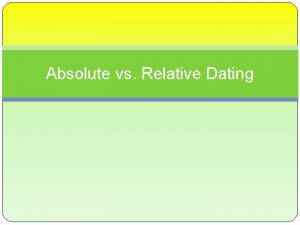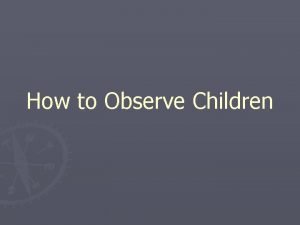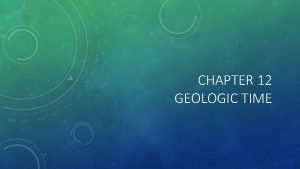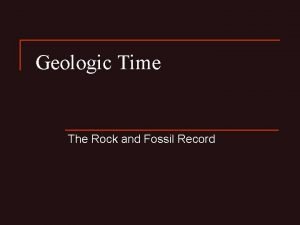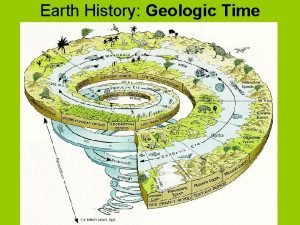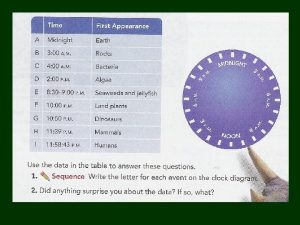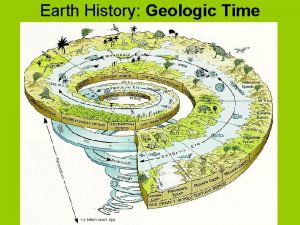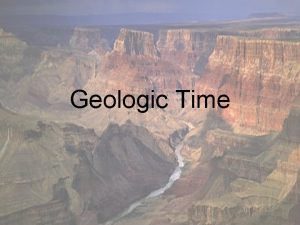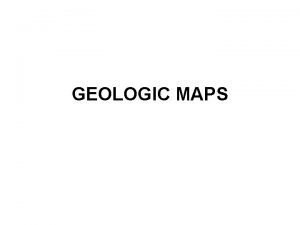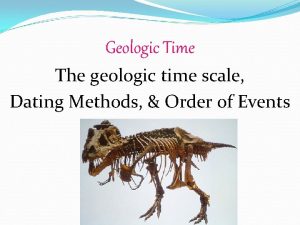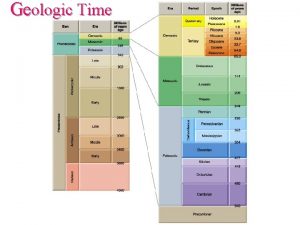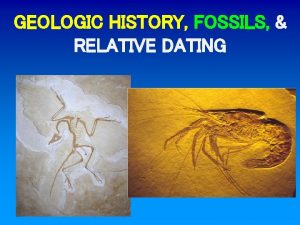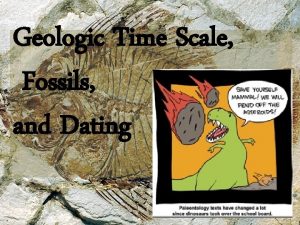Geologic Dating Chapter 4 The Rock Record Chapter












- Slides: 12

Geologic Dating Chapter 4 - The Rock Record

Chapter 4 -1 How are organisms preserved? Objectives- Define fossils. Describe how organisms are preserved in rock and elsewhere. Key Terms Fossil- remains or traces of an organism that lived long ago. Mold- imprint or hallow in rock that is shaped like and made by an organism. Cast- mold filled with hardened sediments. Amber- hardened tree sap.

Fossils • The remains or traces of organisms that lived long ago are called fossils. – They may be found in whole or part. – Species that lived long ago but can no longer be found on the earth’s surface are said to be extinct. Fossils in Rock * Many fossils are found in sedimentary rock that was once under water. * A fossil begins to form when an organism dies, is buried with sediment and undergoes decay. It takes millions of years for fossils to form.

Fossil Formation A mold is formed when organisms leave a hollow opening. When the opening fills up with sand or mud that hardens, it forms a cast. An imprint is another form of fossil evidence, which is created when marks of an organism are left in the rock.

Fossil Formation con’t Fossil found in Ice and Tar are well preserved and have undergone little decay. Siberia and Alaska’s frozen soil have preserved larger animals. Fossils in Amber (sap from trees) have perfectly preserved organisms in their original state. Petrification occurs when minerals replace remains of organisms.

Chapter 4 -2 Why do scientist study fossils? Objective- explain how fossils are clues to earth’s past. Caprolite- fossil dung or the stomach contents of ancient animals. Gastrolith- stone used to grind food. • Fossils show many different species lived at different times throughout Earth’s history. • Fossils show species have changed or evolved over time. • Fossils show the Earth’s climate and environment has changed over time.

Chapter 4 -3 How do fossils help us date rocks? Objective- describe how relative ages of fossils and rock layers can be determined. Law of Superposition- states that each undisturbed sedimentary rock layer is older than the layer above it. * When rock fragments are deposited into layers (strata) the oldest layers are on the bottom and the youngest layers are on the top. Relative age- age of an object compared to the age of another object. *Does not tell us the exact age but an approximate age. Index fossil- fossil used to help determine the relative age of rock layers. *Used to determine the relative age of rocks. Fossils have to be unique and short lived. Trilobites 590 -250 million yrs ago.

Law of Superposition

Chapter 4 -4 How is a rocks absolute age determined? Objectives- Define absolute age in rocks and fossils. Describe ways used to measure it. Absolute age- true age of a rock or fossil. Half-Life- length of time it takes for one-half the amount of a radioactive element to change into a stable element. *Absolute age tells scientists the approximate number of years ago a rock layer formed. *Radioactive elements emit, or give off, particles and energy. This process is called decay. It create new elements that are not radioactive. *Each radioactive element decays at a regular steady rate.

Chapter 4 -4 Half-life; the time it takes for one-half of the mass of a sample of a radioactive element to decay.

Chapter 4 -4 Carbon 14 • Used to date the remains of living things. • Is a radioactive form of carbon. • Decays into nitrogen gas. • Half-life is 5, 800 years. • Used to determine the age of wood, bones and once living materials under 50, 000 years old.

Carbon Radiometric dating Carbon 14
 Compare geologic time with the geologic column.
Compare geologic time with the geologic column. In traditional dating patterns dating behavior
In traditional dating patterns dating behavior Rock cycle song (sedimentary igneous metamorphic)
Rock cycle song (sedimentary igneous metamorphic) Define relative dating
Define relative dating Chapter 21 fossils and the rock record
Chapter 21 fossils and the rock record Example of running record observation of a child
Example of running record observation of a child Chapter 12 geologic time
Chapter 12 geologic time Rock cycle sedimentary
Rock cycle sedimentary Compaction and cementation
Compaction and cementation Rock climb
Rock climb Chapter 3 standardized test practice answers
Chapter 3 standardized test practice answers A rock climber's shoe loosens a rock and her climbing buddy
A rock climber's shoe loosens a rock and her climbing buddy Rock cycle images
Rock cycle images



